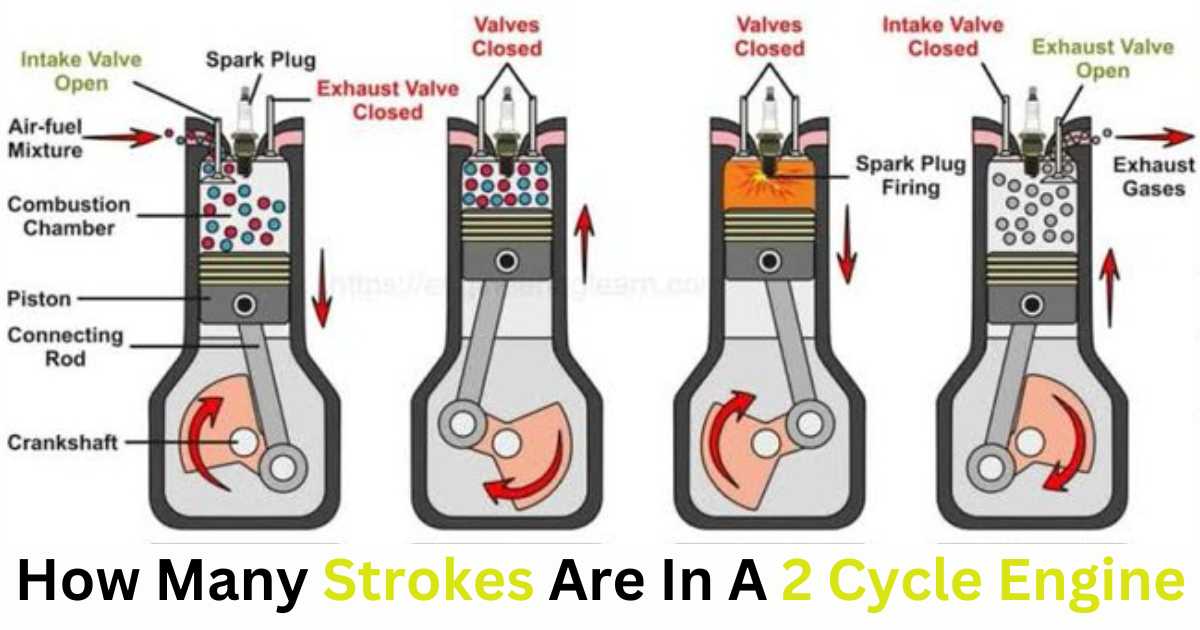How Many Strokes Are In A 2 Cycle Engine: Engines can be confusing with all their parts and processes. If you’ve ever looked inside a chainsaw or a dirt bike and asked,” how many strokes does a 2-cycle engine have?”, you’re not the only one. This we will explain how a 2-cycle engine works in simple terms, including how many strokes it has and what makes it run.

How Many Strokes Are In A 2 Cycle Engine
The Four-Stroke Frenzy Vs. The Two-Stroke Tango
Okay, imagine engines are like two teams in a race. One team, the four-stroke engine, takes four big steps to finish the race; breathe in, squeeze, bang, and breathe out. It’s like a runner packing themselves through four stages. The other team, the two-stroke engine, does things differently. They take just two big steps to finish the race. It’s like they found a shortcut! They still do the same things – breathe in and out, squeeze, and bang – but they do it faster. It’s like comparing a long, slow dance to a quick, snappy one.
The Two-Stroke Symphony: A Dance Of Combined Steps
The 2-cycle engine is smart because it does two things at once that a four-stroke engine does separately. Let’s look at how it works:
Step 1: Squeeze & Breath In – The piston goes up, squeezing the air-fuel mix in the cylinder. At the same time, a new mix comes in through a special opening. It’s like doing two jobs at once!
Step 2: Bang & Breath Out – The piston goes down, squeezing the mix even more. A spark lights it up, making power. But that’s not all. As the piston goes up again, it closes the opening where new mix comes in. It also opens a hole for burnt gases to go out, making room for fresh mix.
So, in a 2-cycle engine, it’s like combining squeezing and breathing in, as well as banging and breathing out, into just two moves. This makes the engine simpler with fewer parts, which is pretty clever!
How Many Endorsements Does A CDL Have
The Allure Of The Two-Stroke: Power Packed And Compact
The two-stroke engine has several benefits that make it great for certain uses:
Simple and Easy: With fewer parts, it costs less to make, is easier to fix, and is lighter.
Strong for Its Size: Two-stroke engines produce more power for their size compared to four-stroke engines. This makes them perfect for tools like chainsaws, weed whackers, and motorcycles where you need a powerful but light engine.
Fast and Exciting: The simple design allows the engine to run at higher speeds, giving it a thrilling performance.
Two Sides To Every Coin: The Trade-Offs Of Two-Stroke Technology
While two-stroke engines have clear benefits, they also have some downsides to think about:
More Pollution: Because intake and exhaust happen together, more emissions can escape compared to four-stroke engines. Some unburnt fuel-air mix can get out during exhaust.
Oil Mix Needed: You need to mix oil with the fuel to keep the engine lubricated. This oil burns with the fuel, adding to emissions.
Less Fuel Efficient: Two-stroke engines can use more fuel because some of it doesn’t burn completely and gets lost.
The Two-Stroke Niche: Where Power And Simplicity Collide
Two-stroke engines are great for equipment that needs to be light, powerful, and simple. They have an efficient design, high power for their weight, and can run at high speeds. However, they produce more emission and use more fuel, making them less ideal for situations that need cleaner and more fuel-efficient engines.
So, next time you hear a two-stroke engine in a landscaping tool or a motocross bike, remember how its piston works – just two strokes to deliver a strong burst of power.